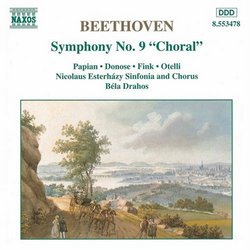A Recording of the "Choral" Symphony
Robin Friedman | Washington, D.C. United States | 10/09/2003
(4 out of 5 stars)
"Beethoven completed his final symphony, the Symphony No. 9 in D Minor, Opus 125 in 1824, twelve years following the completion of his earlier eight symphonies. The symphony is always known as the "Choral" in that Beethoven introduced into the symphony for the first time vocal music, in the form of a chorus, soloists, and quartet, settting Schiller's poem, "Ode to Joy." Beethoven had long had the ambition of setting Schiller's poem to music.It is sometimes forgotten that Beethoven wrote a great deal for the human voice. His works include many songs, the opera "Fidelio" two masses, an oratorio, cantatas, and much else. In particular, Beethoven's "choral fantasy" for piano, orchestra and chorus, opus 80 is an earlier attempt in the pattern of the Ninth Symphony. The Ninth Symphony is in four movements with the first three purely instrumental. The final movement of the symphony generally receives the most attention, and new listeners probably should be reminded to hear the entire work, and to listen to the singing in light of the three movements that have proceeded it. The first movement is a questioning, troubled allegro which is heroic and grand in character. It is followed by a lively scherzo featuring brusque interplay between the bassoon and the tympani and a meditative second theme. The third movement is a tranquil and reflective adagio, and the fourth movement consists of an complex orchestral introduction which serves to bridge the three instrumental movements with the choral finale, followed by the setting of Schiller's Ode.Over the years, musical scholars have divided over whether the choral finale is an effective conclusion to a work of pure instrumental music. In addition, the choral finale, with its message that "all men will become brothers" has been used by some for political purposes, some probably good in themselves, some, such as Nazism, vicious. The Ninth is public music in the sense that Beethoven deliberately introduced the human voice, and Schiller's poem, to say something directly and immediately to the listener that, he believed, instrumental music could not sufficiently convey. The listener should try, as much as possible, to listen to Beethoven's music and to read Schiller's poem, and respond, as if for the first time. The specific CD under review is part of a compliation of the nine Beethoven symphonies by the Nicholas Esterhazy Sinfonia and Chorus conducted by Bela Drahos. It is on the Naxos label and sells for a budget price. The soloists are Claudio Otelli, bass, Manfred Fink, tenor, Hasmik Papian, soprano, and Ruxandra Donose, mezzo. The liner notes are brief, but a translation of Schiller's poem is included.This is a performance by a small orchestra, actually an augmented chamber orchestra, and it loses something in massiveness and solemnity. The use of a chamber orchestra works well here, but it is probably more appropriate for some of Beethoven's earlier symphonies than for the Ninth. The outstanding feature of the performance, conversely, is its lyrical character, even in the opening movement. The instrumental lines are clear and the listener may follow the sometimes sinuous character of Beethoven's melodies in the strings and winds. The adagio is lovely and song-like. Tempos are slightly fast.The choral finale was very well done by the orchestra and the singers. It was the most massive section of this performance, undoubtedly due to the addition of the chorus. I particularly enjoyed the singing ot tenor Manfred Fink, during his singing of a country-band type march theme that Beethoven inserted in the middle of the choral music.This is inspirational music, with Beethoven trying deeply to convey his message to the listener. For all the sniping that sometimes takes place at Beethoven and the "heoric" or "universal" style, this symphony remains music that must be heard. This recording is not the only "Ninth"; but it will allow the listener to get to know this music and to respond."
Be warned - this is done by a chamber orchestra!
Shota Hanai | Torrance, CA | 08/08/2006
(4 out of 5 stars)
"... but unless you're accustomed to recordings of Beethoven's epic Ninth Symphony done by major world-class orchestras (Berlin and Vienna Philharmonic just to name a few), and absolutely can't tolerate the work done by a thirty to forty piece ensemble, do give this performance some time.
Surely, detractors find it weak and lacking the power and drama large orchestras have, but the important thing is, you're hearing a recording which, in a sense, is more accurate during Beethoven's time. Strangely, much of the existing recordings are done adding more players over the years.
The chamber orchestra Nicolaus Esterhazy Sinfonia, under the baton of Bela Drahos, performed and recorded all nine symphonies, as well as couple other works by Beethoven. The ensemble is extremely well played; it's comprised of some of the best players from larger orchestras from Hungary. So are the chorus and the vocal soloists. The baritone and tenor in particular has a voice fit for a small ensemble. The relatively fast tempo is preferable to my taste, and both the first and second segments of the A section from the Scherzo is repeated.
Yes, it's not a typical overly powerful performance, but it's still worth a listen so you can get a different, even historically more accurate, insight on this work."


 Track Listings (4) - Disc #1
Track Listings (4) - Disc #1